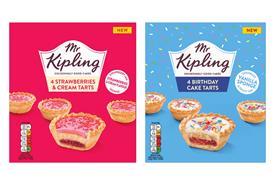n In 1962 The Grocer published a book to celebrate its centenary and in it Howard Fox reported on predictions about the grocery shop of the future. For our first issue of the third millennium we reprint his article to see how much of the prophecy is correct so far
What is the grocery store going to look like in the future? A palace of electronic devices? A mass of buttons to push and levers to pull? Automation to the ceiling and down to the basement? The answer seems to be both yes and no...with the balance in favour of no.
Who gives the answer? Well, it's someone who should know more than most what he's talking about in this field: James Birnie, general director of styling and design for the Reynolds Metals Company, Virginia, USA. Having given a lot of study to the possible shape of things to come, he lately made his conclusions available to the American Management Association. Here's what they add up to.
The housewife would react to a grocery establishment that substituted the push button for the mass display and shopping cart with frustration, resentment, boredom and fewer purchases. The supermarket of the future will inevitably have plenty of automation. But the emphasis will be on moving the shopper into and through the store, not moving her purchases through chutes to an automatic bag-filler. They'll have that too, but only as an optional feature for the harried husband whose only desire is to get the groceries and get home.
To please the woman, the supermarket of the 1970s will have less regimentation and more personal service, convenience and relaxing atmosphere all incorporated in a basic design that changes the rectangular shape of today's store into an open, circular structure which eliminates parking problems and makes shopping a pleasure.
"You can't sacrifice human emotion for the sake of mechanical efficiency," says Mr Birnie. "Everyone still loves the old country store and the corner grocery." He adds: "We've got to get back to that principle in supermarket design. Future stores must cut out the regimentation of today's shopping and at the same time, be more convenient. Women spend a lot of time in supermarkets, and we've got to make their time more pleasant."
The big supermarket of the future will be a series of little personal shops where the housewife can compare notes with the grocer and the butcher. Each shop will be decorated individually to conform with its product. There will be much more colour and no more long white walls.
Automation will be used to reduce walking, not the comparative selection of items. The housewife won't patronise a store where she is expected to choose an item displayed behind glass, push a button and pick it up outside. She likes to pick up the package and compare it with another. The future supermarket will give the shopper a choice of automated shopping or personal service. Items will be displayed both ways.
Packaging will undergo a similar change. It will combine more convenience with new shapes and forms to break the monotony of the standard rectangular package. Shape pyramids, octagons, spheres will be considered equally with colours on packaging design.
Parking around the store could take almost any pattern, depending on traffic. With parking facilities around the entire circumference of the structure, no car would be more than about 250 ft from the entrance. Spaces would be provided within parking areas for helicopters.
Canopied moving pavements would carry the shoppers to and from the store but with optional stationary walks also provided. Service traffic would be separated from customer traffic by underground tunnels curving to either side of the store and leading to a basement receiving and service area.
Instead of the long straight aisles of today, they will be broken up at various angles, giving diversion to help make shopping a pleasant and surprising experience rather than a dull routine. The shopper will stand on moving aisles and step off when she sees an item she wants.
Further ahead Mr Birnie has foreseen a supermarket in which the housewife would choose her purchases from a comfortable lounge chair but not with a push button. "Eventually, the entire perimeter of a store may be arranged in lounges, with the shopping area a huge revolving island. The housewife would sit, talk with her friends and pick items as they pass by." n
{{MANAGEMENT FEATURE }}
Close menu
- Home
- Retail & Wholesale
-
Products & Suppliers
- Back to parent navigation item
- Products & Suppliers
-
Product Categories:
- Back to parent navigation item
- Product Categories:
- Alcoholic drinks
- Bakery
- Cereals & breakfast
- Cheese
- Chicken & poultry
- Chocolate
- Confectionery
- Crisps, nuts & snacks
- Dairy
- Fish
- Fresh produce
- Frozen
- Household
- Meat
- Own Label
- Sauces & condiments
- Seasonal
- Soft drinks
- Vaping
- Vegan & plant-based
- World foods
- Suppliers
- People
- Reports & Data
-
Topics A-Z
- Back to parent navigation item
- Topics A-Z
-
Popular topics:
- Back to parent navigation item
- Popular topics:
- Cost of living crisis
- Crime
- Deposit Return Schemes
- Finance
- Government & Regulation
- Health
- Inflation
- Loyalty
- Marketing
- Mergers & Acquisitions
- New Product Development
- Sourcing
- Supply chain
- Sustainability & environment
- Technology
- Ultra Processed Foods
- Vaping
- A-Z all topics
- Content by type:
- Events
- Subscribe now
Sign in to comment on this article
Not logged in before? Register for FREE guest access today.
You will be able to:
- Read more stories
- Receive daily newsletters
- Comment on stories
Advert















No comments yet